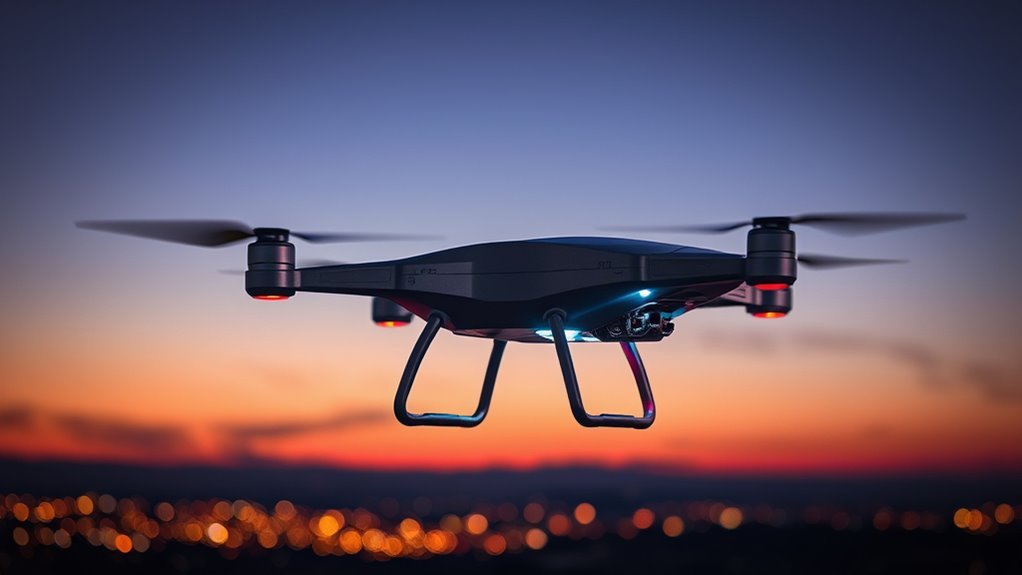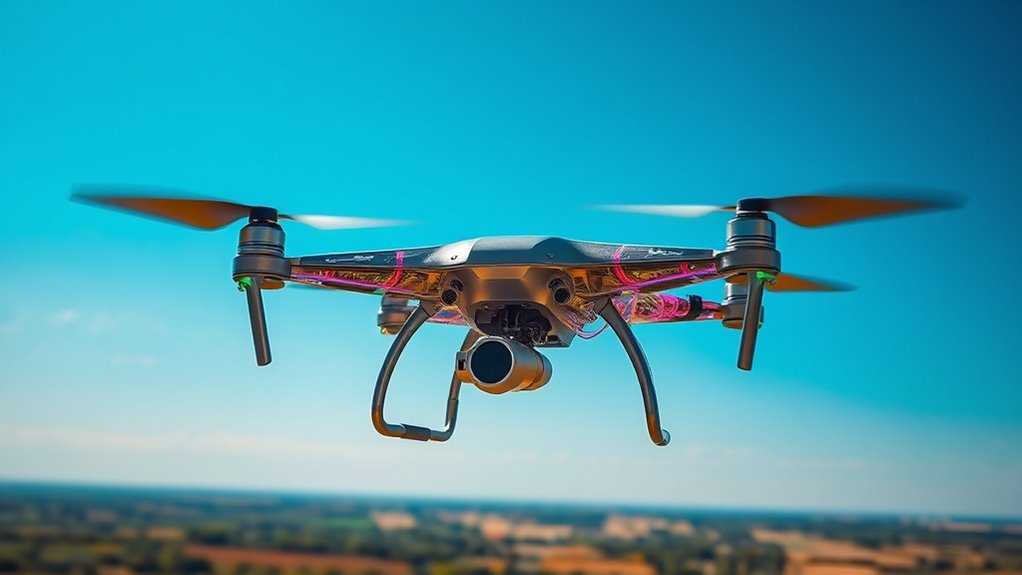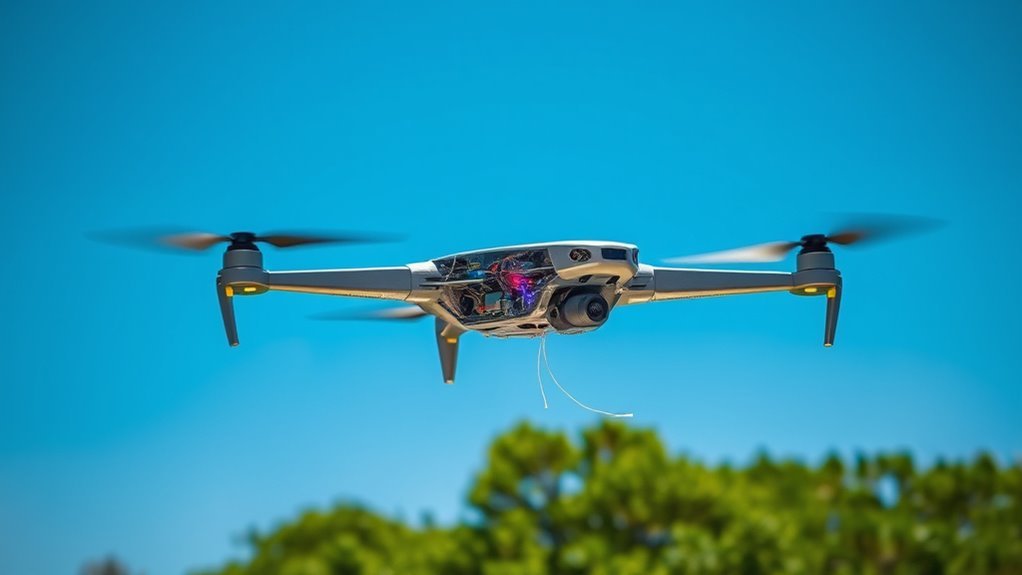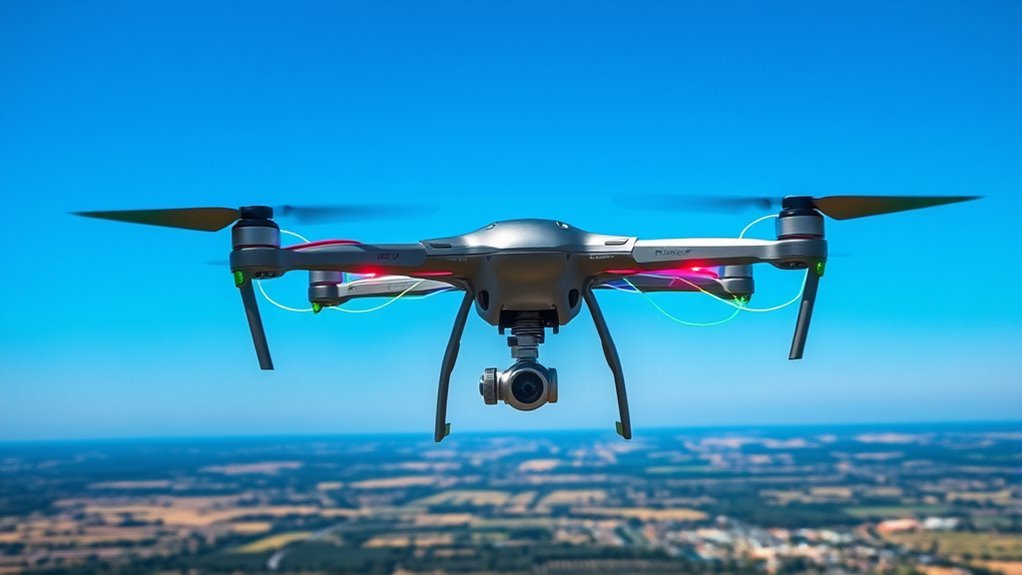A fiber optic drone works by transmitting data through light pulses along fiber optic cables. These pulses, generated by lasers or LEDs, use total internal reflection to travel long distances efficiently. The drone is equipped with sensors for environmental data and a flight controller for stability. Signal amplification maintains data integrity, ensuring rapid communication. This advanced technology enhances various applications like surveillance and inspections. If you’re curious about the components and future trends, there’s more to explore.
Understanding Fiber Optic Technology

Although fiber optic technology may seem complex, it fundamentally relies on the principle of light transmission through glass or plastic strands. At its core, fiber optic basics involve the use of total internal reflection, allowing light to travel long distances without significant loss. When you send data, pulses of light, generated by lasers or LEDs, move through these strands. This method offers higher bandwidth compared to traditional copper cables, making it ideal for high-speed communications. You’ll appreciate how fiber optics can transmit information over vast distances with minimal interference, enhancing your freedom to connect seamlessly. Understanding these fundamentals empowers you to recognize the transformative potential of fiber optic technology in various applications, including telecommunications and networking.
Key Components of Fiber Optic Drones

While you might think of drones as simple aerial vehicles, fiber optic drones incorporate several key components that enhance their functionality and performance. These drones are equipped with advanced drone sensors that facilitate real-time data collection and processing. Fiber cables play an essential role in transmitting this data with high speed and minimal loss.
Here’s a quick overview of the key components:
| Component | Function | Importance |
|---|---|---|
| Fiber Cables | Transmit data rapidly and efficiently | Guarantees high-speed communication |
| Drone Sensors | Collect environmental and operational data | Enables precise navigation and monitoring |
| Flight Controller | Manages flight operations and stability | Ensures smooth and controlled flight |
Understanding these components can help you appreciate the capability of fiber optic drones.
Data Transmission Process

The data transmission process in fiber optic drones is a sophisticated operation that leverages the capabilities of fiber cables to secure rapid and reliable communication. Initially, data encoding occurs, converting information into light pulses that travel through the fiber optic cables. This encoding guarantees that your data maintains integrity over long distances. As the light signals move, they might weaken due to distance or environmental factors, necessitating signal amplification. This amplification process rejuvenates the light signals, ensuring they reach their destination without significant loss. By employing advanced technologies in both encoding and amplification, fiber optic drones can transmit vast amounts of data efficiently, allowing for real-time monitoring and control, ultimately granting you the freedom to manage operations seamlessly.
Applications of Fiber Optic Drones
As fiber optic drones continue to evolve, their applications span a wide range of industries, enhancing efficiency and data collection capabilities. You’ll find these drones particularly beneficial in:
Fiber optic drones are transforming industries by improving efficiency and enhancing data collection across various applications.
- Surveillance applications for security and monitoring
- Infrastructure inspections to assess bridges, towers, and pipelines
- Environmental monitoring to track changes in ecosystems
- Search and rescue operations for locating missing persons in hard-to-reach areas
- Agricultural assessments to evaluate crop health and irrigation systems
Future Trends in Drone Technology
With advancements in technology accelerating at an unprecedented rate, the future of drone technology is poised for transformative changes that will enhance operational capabilities across various sectors. You’ll see a significant shift toward autonomous navigation, allowing drones to operate without human intervention, increasing efficiency and safety in tasks like delivery and surveillance. Coupled with advanced sensors, these drones will gather real-time data with unparalleled accuracy, facilitating smarter decision-making. Imagine drones equipped with AI that can analyze their surroundings and adapt to dynamic environments seamlessly. This evolution will not only empower industries but also liberate you from manual controls, offering a new level of freedom in drone operation. As these capabilities develop, the possibilities for innovation are virtually limitless, especially with AI-enhanced obstacle avoidance features that ensure safer flights in complex environments. Additionally, the integration of advanced collision sensors will further elevate the reliability and safety of drone operations, making them indispensable tools in various industries.
Frequently Asked Questions
What Are the Main Advantages of Fiber Optic Drones Over Traditional Drones?
When considering fiber optic drones, you’ll find high-speed connectivity and enhanced data transmission essential benefits. Unlike traditional drones, they offer superior reliability and efficiency, enabling you to gather real-time information with unparalleled clarity and speed.
How Do Weather Conditions Affect Fiber Optic Drone Performance?
Weather conditions considerably impact fiber optic drone performance. Rain or snow can cause performance variation due to signal interference, while high winds may reduce stability, limiting operational capabilities and potentially affecting data transmission efficiency.
Are Fiber Optic Drones Suitable for Nighttime Operations?
Yes, fiber optic drones can be suitable for nighttime operations when equipped with advanced night vision and lighting technology. These features enhance visibility and guarantee safe navigation, providing you the freedom to operate effectively in low-light conditions.
What Is the Maintenance Cost for Fiber Optic Drones?
Imagine soaring through the night sky, but maintenance factors can weigh you down. A thorough cost analysis shows that fiber optic drones require regular upkeep, typically ranging from $500 to $2,000 annually, depending on usage and components.
Can Fiber Optic Drones Be Used for Emergency Response Situations?
Yes, fiber optic drones can be invaluable in emergency response situations. They provide real-time data transmission, enhancing situational awareness and allowing responders to assess critical infrastructure quickly, ensuring efficient and effective disaster management and rescue operations.

